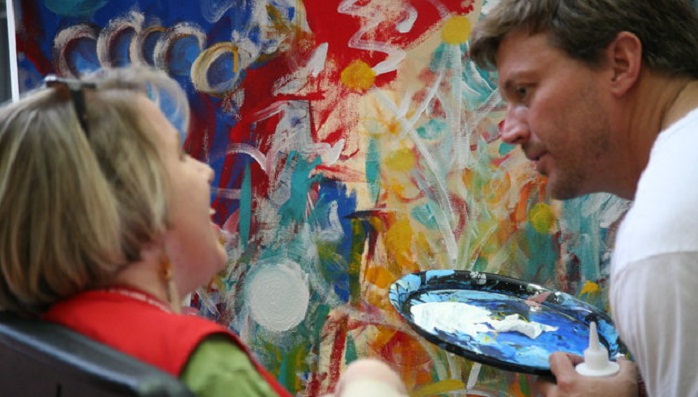While he recovered in Cedars-Sinai Medical Center I found myself roaming the halls which, luckily for me, were adorned with a museum-quality art collection, including the work of Paul Klee, Marc Chagall, Helen Frankenthaler and Robert Rauschenberg.
I was particularly glued to a corridor lined with Ellsworth Kelly drawings, simple black-and-white lined depictions of plants. They floated in the white space ever so lightly, like pressed flowers whose insides had faded away. In a time characterized by fatigue, chronic nausea and depression, those fragile black shapes provided me space to breathe. The hospital smells and sounds faded away in their presence as if by magic.
I was not the sick one, but was nonetheless overwhelmed with gratitude for those humble monochromatic forms, and in awe of their power. To members of the art therapy community, this ostensible miracle is more like science. The effects of art viewing are not just emotional, but physical as well.
"I have shown art reproductions to very ill patients, even in intensive care," art therapist Irene David, director of therapeutic arts at Bellevue Hospital Center, told The Huffington Post, "and observed calmer states and pleasure elicited -- a kind of life-enhancing lift to neutralize the clinical experience and ambiance of hospitalization."
I reached out to David after reading about a February 2015 study in which researchers from UC Berkeley determined that experiencing wonder during activities like viewing powerful art may lower the levels of certain chemicals, particularly those that cause inflammation and can eventually lead to diabetes, heart attacks and other illnesses.
In the experiment, 200 young adults detailed how much they experienced wonder and amazement in a given day. Researchers then obtained samples of gum and cheek tissue (oral mucosal transudate), finding that those who claimed to have experienced greater levels of wonder and amazement had the lowest levels of cytokine interleukin 6 -- a marker of inflammation. Cytokine is necessary to the body for fighting infection, but in large quantities, it can lead to type 2 diabetes, heart disease, arthritis and even Alzheimer`s.
How much wonder a person experiences in a given day isn`t exactly a measurable quota (and art isn`t the only way to experience such an emotion -- being in nature is also cited in the report). But the findings roughly demonstrate that "positive emotions are associated with the markers of good health," Dr. Jennifer Stellar, of Toronto University, explained.
"Rather than seeing a walk through the park or a trip to the museum as an indulgence, we hope people will view these kind of experiences as important ways to promote a healthy body in addition to a healthy mind," Stellar continued. "Folding these kinds of positive experiences into your daily routine may be more important for health than we previously realized."
Donna Betts, president of the American Board of Art Therapy, was far from shocked by the findings.
"Stellar and her team’s results do not surprise me in the least," she wrote to HuffPost. "I’m thrilled to learn of some good research on the benefits of viewing artwork. I would love to see some robust research on the benefits of art making and art therapy in increasing immune system functioning."
While Betts was unfamiliar with other studies involving levels of cytokine interleukin, she mentioned an ongoing study with Drexel University`s Girija Kaimal researching the effects of art-making classes on family caregivers of patients with cancer.
Specifically, Kaimal is looking at art`s ability to lower cortisol levels, which are associated with stress and anxiety.
Through my previous conversations with art therapists, I`d been made aware of art`s ability to bolster mental and emotional health. But the physical aspect was new to me. Betts referenced a slew of studies chronicling art`s ability to reduce pain, counter fatigue and promote general physical wellness.
Most of all, Betts stressed the fluidity of the boundary separating the physical from mental. "There is increasing awareness on a global scale of the mind-body connection and the implications for psychological and physical health," she said. "It’s the idea that the mind and the body are interconnected, the health of one affecting the other."
David also commented on the ability of physical health to bleed into mental health, and vice versa. "Physical illness invariably brings a host of emotion -- typically anxiety and/or depression. Hence, there is particular therapeutic gain in externalizing or dissipating these states through artistic expression. Ultimately, this externalization can help people cope with prognoses, treatment and overall adaption."
Both David and Betts also agreed that, while viewing art is beneficial, the effects of making art are even stronger. As David put it: "I think there is a particular sensation in the actual creation of art, especially the tactile use of materials -- using one’s hands and implements in relation to inner thoughts, feelings and perceptions brings forth all at once a spectrum of reward.
Even in the case of disability necessitating adaptive items, there is [a] direct and immediate giving of oneself. Making art is giving to oneself in both the process and the validating product."
Whether or not you`re an aspiring artist, this kind of encouragement is vital. If you have a day off, why not head to a museum, where a motionless image made in another time and place could in some way speak to you, make you smile or gasp? Why not test out the way clay feels expanding inside your grip? According to art therapy, seeing art isn`t just a luxury, a social outing or fodder for your next Instagram upload. It`s medicine for the eyes, the mind, the heart and possibly even the body. And it`s so much more pleasurable than swallowing a pill.
More about:















































